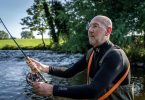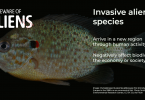Press notice sent on behalf of the Angling Trust, Wildfowl & Wetlands Trust (WWT), RSPB, Worldwide Fund for Nature, Wildlife Trusts, Wye & Usk Foundation, Marine Conservation Society, Severn Rivers Trust, Salmon & Trout Association and Campaign to Protect Rural England.
A Proposal to build a Barrage across the Severn Estuary ‘could be absolutely devastating’, MPs have heard.
The Angling Trust, Wildfowl & Wetlands Trust (WWT) and RSPB told the House of Commons Energy & Climate Committee they all supported tidal energy development in the Severn, but that the current proposal lacks detail and claims that it would not unacceptably damage wildlife and large areas of habitat are “not realistic”.
As well as doubting claims about the environmental impact of the barrage, all four organisations expressed support for future alternative smaller projects in the Severn Estuary to test and develop new tidal energy technology which Britain could export globally.
Angling Trust National Campaigns Coordinator Martin Salter told the Committee a full-width barrage across the estuary would mean fish dying due to sudden changes in water pressure and salinity, and through turbine strikes. He said:
“Claims that these turbines are fish friendly are absolute guff. This is 24/7 fish mincing. Turbines kill fish above a tip speed of 6-7 metres per second. The Hafren proposal is for a tip speed of 9 metres per second. How on earth can they make press statements that these are “fish-friendly”. They are simply not.
“This drives a coach and horses through all environmental protections that governments have signed up to. The impact could be absolutely devastating on both the commercial fishery, on the recreational fishery and on highly protected habitat.”
WWT Chief Executive Martin Spray told MPs:
“This represents such a massive investment and such a massive change to the estuary that we do need more information. We have got to get a little more clever about how we address the environment. There is potential for energy generation but we have to come up with environmentally sustainable, acceptable and sensible solutions.”
RSPB Head of Site Conservation Policy Kate Jennings said experiences elsewhere suggest smaller projects would be a better way to test new technologies rather than repeat experiences in the Netherlands:
“The experience in the Eastern Scheldt estuary in the Netherlands where they built a storm surge barrier in the 1980s is the best comparator for the Severn Barrage. What they found is that 30 years after construction the estuary is still losing intertidal habitat. They think it will go on losing habitat for at least a century.
“The official Government study into the Severn Barrage proposal in 2010 showed that there would be significant effects on the populations of 30 species of birds and that in addition to the Severn it would also have negative impact on at least five other internationally important wildlife sites nearby.”
Kate also addressed claims that a barrage would reduce flood risk by protecting against storm surges, telling MPs a barrage could actually increase flood risk upstream:
“There are other forms of flood risk. A significant one being fluvial (rivers) and managing that relies on the ability to get water out of the Severn. Holding it back behind a barrage would compromise that and tide-lock drainage. We don’t have enough details of the proposals.”
The Angling Trust, WWT, and RSPB have also agreed a joint position regarding the Severn Barrage with several other environmental organisations – WWF-UK, the Wildlife Trusts, Wye & Usk Foundation, Marine Conservation Society, Severn Rivers Trust, Salmon & Trout Association and Campaign to Protect Rural England. The agreed position was sent in a letter to Hafren Power and Peter Hain who supports the barrage proposal. The position was summarised as:
“We support the deployment of renewable energy as an essential element of the steps required to decarbonise the UK economy, and acknowledge the potential of the Severn Estuary for renewable energy generation.
“However, we believe that renewable energy deployment can and should be delivered without unacceptable impacts on the environment. To date we have not been presented with sufficient detail on the current proposal, or any assessment of the impacts of that proposal, which would allow us to consider the extent to which its impacts would differ from those of the completely unacceptable high head Cardiff to Weston barrage (especially in the long term). That said, we remain deeply sceptical that a shore-to-shore barrage can be delivered without unacceptable impacts on the environment.
“Given the likely scale of the impacts of such a development, and the associated environmental, social, technical, legal and investor challenges and risks, we believe that an approach which focuses on smaller scale deployment, sited and designed to maximise energy output whilst minimising environmental impact, is more likely to deliver an acceptable solution in a timescale compatible with the urgent need to address climate change and maintain electricity supply.”
Further details of the environmental organisations’ concerns were outlined in the letter as below:
We attach great value to the Severn Estuary for its international importance for wildlife, and for the economic and social benefits that this provides;
We see climate change as the greatest medium to long term threat to biodiversity, and we support the deployment of renewable energy as an essential element of the steps required to decarbonise the UK economy and maintain our electricity supply. We also acknowledge the potential of the Severn Estuary for renewable energy generation;
That said, we recognise that, like all forms of development, inappropriately designed and/or sited renewable energy developments can cause serious, irreparable and unnecessary harm to biodiversity;
To date we have not been presented with sufficient detail on the current proposal, or any assessment of the impacts on the impacts of that proposal, which would allow us to consider the extent to which the impacts of the current proposal could differ from those of the completely unacceptable high head Cardiff to Weston barrage (especially in the long term);
However, we remain deeply sceptical that a shore-to-shore barrage on the scale of that envisaged can be delivered without unacceptable damage to the Severn Estuary, its wildlife and heritage, and the tourism, recreational and commercial activity that this supports.
We acknowledge that the Severn Estuary is a highly dynamic ecosystem that will change over time (and has done so in the past). The very nature of the estuary means that all devices installed to generate electricity from it will in some may affect that ecosystem. We wish to see an approach to the development of renewable energy proposals that delivers maximum energy yield for minimum environmental impact. If current technologies cannot achieve this, then efforts should be concentrated on the development of less damaging alternatives.
The key concerns of the NGOs regarding the impacts of a Severn Barrage are:
- Impacts on the geomorphology, including longterm changes following construction of a barrage structure;
- Impacts on hydrology and sea level, including near and farfield effects, impacts on flood risk, water quality, wave climate, land drainage and groundwater;
- Impacts on estuarine habitats – including both habitat loss at the time of construction, and that associated with changes in geomorphology and the tidal regime following construction;
- Impacts on birds including those associated with habitat loss and change;
- Potentially fatal impacts on rare and highly protected fish species populations including direct and indirect (cavitation effects) mortality through collision with turbine blades (a risk exacerbated by with multiple passages through the turbines), delays to fish migration, enhanced predation, changes in water quality and salinity, and the loss of fish nursery habitat. Most of these fish populations are already well below ‘Favourable Conservation Status’ and are therefore particularly vulnerable to further pressures; 90% of the world’s Twaite Shad population risks extinction and 25% of England and Wales’ salmonid habitat could be excluded by a barrage;
- Impacts on coastal and terrestrial habitats, including those associated with changes in sea level, hydrology and water quality;
- Impacts on the landscape, seascape, archaeological and amenity value associated with both the construction of a barrage and associated impacts and infrastructure.
Key Challenges for Hafren Power:
We believe that there are five key tests which must be satisfied by proponents of any tidal barrage or other renewables technology proposal in the Severn Estuary before any scheme could be considered for consent (whether via a hybrid bill or any other mechanism):
- The assessment of the nature and scale of the environmental impacts of the proposed barrage on the estuary must be robust and subject to rigorous peer review based on terms of reference agreed with NGOs in advance. This will require not only an understanding of the impacts of the proposed development, but also of the structure, function, and ecology of the estuary (e.g. fish behaviour within the estuary). A robust assessment of impact is a prerequisite for the identification of potential mitigation and compensation measures;
- To achieve this, all technologies must have been developed and adequately tested, in conditions which accurately mirror those found in the Severn Estuary;
- Environmental impacts on geomorphology (including intertidal habitat loss), birds, fish, water quality and adjacent terrestrial habitats over the full life of a barrage structure must – as a minimum – be demonstrated to be within the realms of what it is practically possible to compensate for on a like for like basis within the UK;
- It must be demonstrated that required ‘like for like’ compensatory measures can be secured and delivered in advance of construction, and will be effective in the short, medium and long term;
- Impacts on jobs, land drainage and flood risk etc, along with the costs of compensatory measures, will need to be factored into any analysis of the economic feasibility of a proposal, and will need to demonstrate that the proposal would provide a good deal for taxpayers AND consumers.
Application of the Habitats Directive Article 6(3) and 6(4) tests will act as a litmus test for the viability and acceptability of any proposal. These require that the nature and scale of impacts on all Natura 2000 sites affected (SPAs, SACs and (as a matter of UK Government policy) Ramsar sites) be thoroughly assessed. If it is not possible to ascertain that the development will not have an ‘adverse effect’ on one or more of these sites, it may only be consented if it can be demonstrated that there are no less damaging alternative solutions that could deliver the same public interest, that there are imperative reasons of overriding public interest why it should proceed in spite of its effects on the integrity of Natura 2000 site(s), and that sufficient, adequate and effective compensation can be secured to maintain the coherence of the Natura 2000 network of SPAs and SACs in the short, medium and long term.
Recent Developments:
In November 2012, RegenSW and partners published a new discussion document, “Bristol Channel Energy: A Balanced Technology Approach”, which outlines most of the known ideas for marine energy generation from the Bristol Channel/Severn Estuary system and proposes adopting a multi technology approach. The report’s authors highlight that the key advantage of this approach would be to enable the incremental roll out of a series of large scale energy schemes as technologies are proven and their environmental impacts can be properly managed. We welcome this discussion document and the approach it advocates, which could facilitate a better understanding of the impacts of tidal energy generation at much lower risk to investors, the environment, and the wider business and resident communities.








